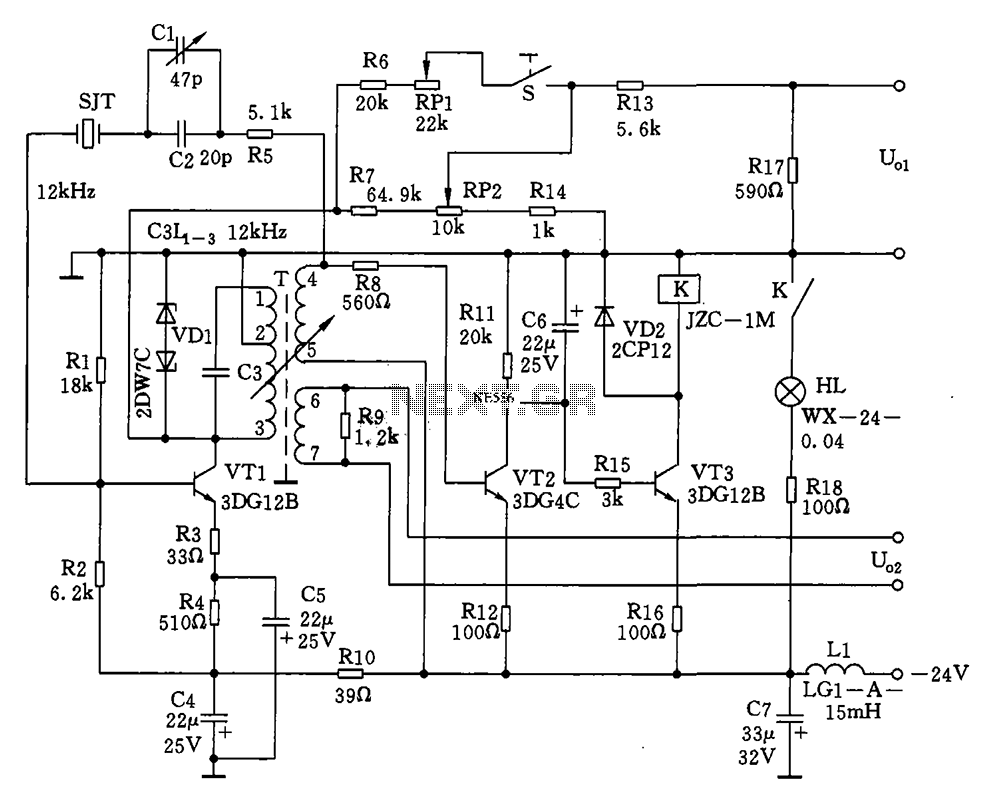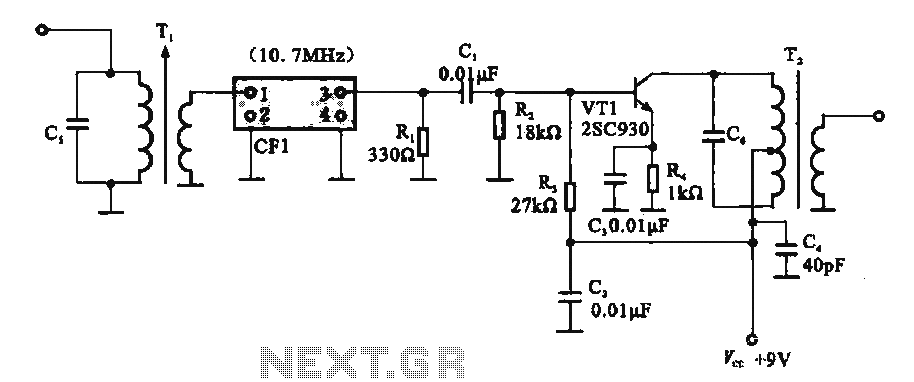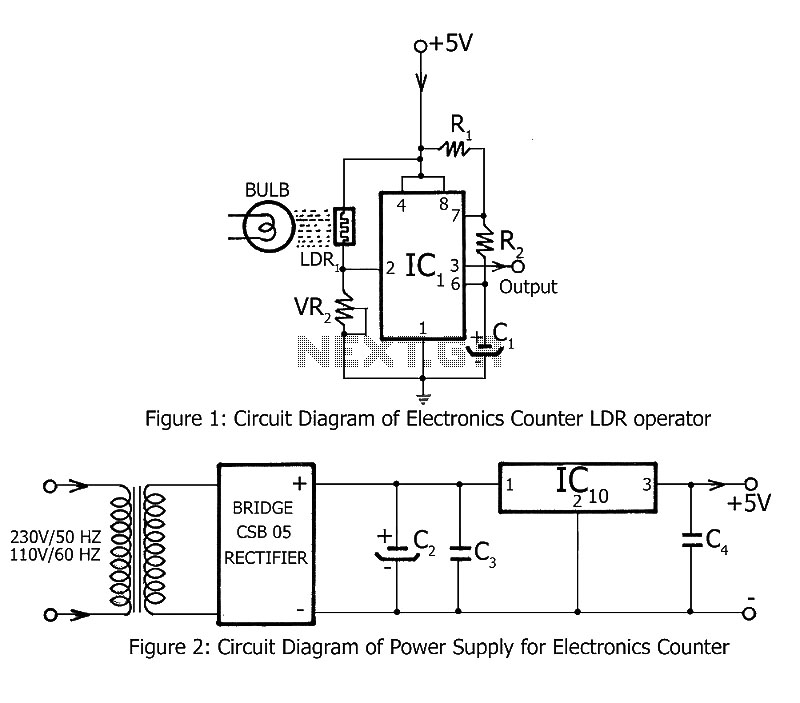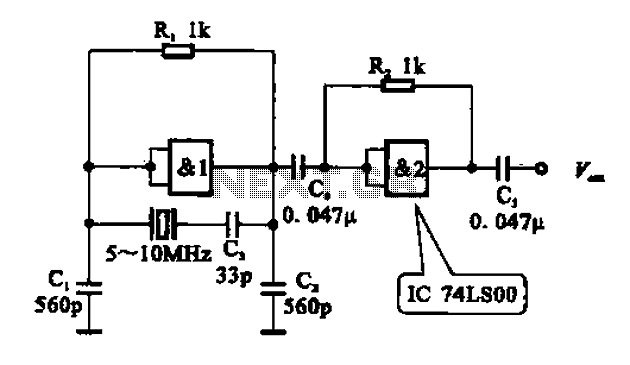
Amproluck W850ES microwave auto-sensing electronic microwave circuit diagram
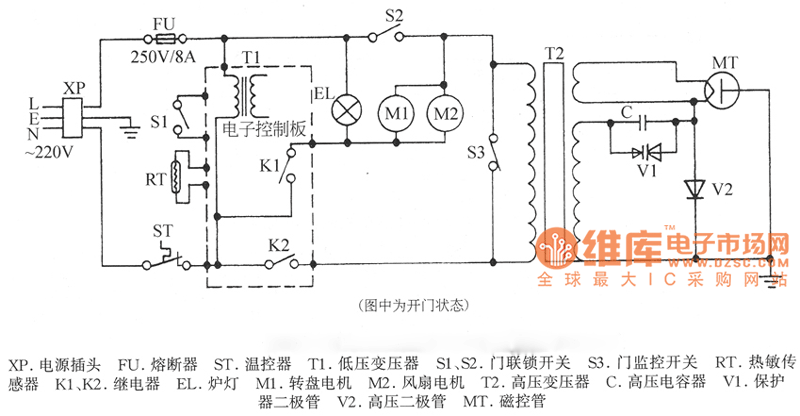
XP power plug, FU fuse, ST temperature control, T1 low-voltage transformers, S1, S2 door interlock switch, S3 threshold control switch, RT thermal sensor, K1, K2 relay, EL furnace light, M1 wheel motor, M2 fan motor, T2 high-voltage transformer, C high voltage capacitor, V1 protection diode, V2 high voltage diode, MT magnetron.
The described circuit comprises several essential components that work together to ensure safe and efficient operation of a heating system, likely for an industrial application.
The XP power plug serves as the primary power input, delivering electrical energy to the circuit. The FU fuse is included for overcurrent protection, preventing damage to the circuit in case of a fault. The ST temperature control regulates the operating temperature of the system, ensuring it remains within safe limits.
Low-voltage transformers (T1) convert the mains voltage to a lower level suitable for use by other components. The door interlock switches (S1, S2) ensure that the system cannot operate unless the doors are securely closed, enhancing safety. The S3 threshold control switch may be used to set operational limits for the system, triggering different actions based on temperature or other parameters.
The RT thermal sensor monitors temperature and provides feedback to the control system, allowing for adjustments based on real-time conditions. The K1 and K2 relays act as switching elements that control the power to various components based on signals received from the control logic.
The EL furnace light indicates when the system is operational, providing visual feedback to the user. The M1 wheel motor and M2 fan motor are responsible for mechanical movement and airflow, respectively, essential for maintaining efficient heating and cooling cycles.
The high-voltage transformer (T2) steps up the voltage for the magnetron (MT), which generates microwave energy for heating applications. The high voltage capacitor (C) stores electrical energy for discharge, supporting the operation of the magnetron. Protection is provided by the V1 protection diode and the V2 high voltage diode, which safeguard the circuit from voltage spikes and ensure proper current flow.
This schematic illustrates a comprehensive design that integrates safety features, temperature control, and efficient power management, making it suitable for various heating applications.XP-power plug, FU-fuse, ST-temperature control, T1-low-voltage transformers, S1, S2-door interlock switch, S3-threshold control switch, RT-thermal sensor, K1, K2-relay, EL- furnace light, M1-wheel motor, M2-fan motor, T2-high-voltage transformer, C-high voltage capacitor, V1-protection diode, V2-high voltage diode, MT-magnetron.. 🔗 External reference
The described circuit comprises several essential components that work together to ensure safe and efficient operation of a heating system, likely for an industrial application.
The XP power plug serves as the primary power input, delivering electrical energy to the circuit. The FU fuse is included for overcurrent protection, preventing damage to the circuit in case of a fault. The ST temperature control regulates the operating temperature of the system, ensuring it remains within safe limits.
Low-voltage transformers (T1) convert the mains voltage to a lower level suitable for use by other components. The door interlock switches (S1, S2) ensure that the system cannot operate unless the doors are securely closed, enhancing safety. The S3 threshold control switch may be used to set operational limits for the system, triggering different actions based on temperature or other parameters.
The RT thermal sensor monitors temperature and provides feedback to the control system, allowing for adjustments based on real-time conditions. The K1 and K2 relays act as switching elements that control the power to various components based on signals received from the control logic.
The EL furnace light indicates when the system is operational, providing visual feedback to the user. The M1 wheel motor and M2 fan motor are responsible for mechanical movement and airflow, respectively, essential for maintaining efficient heating and cooling cycles.
The high-voltage transformer (T2) steps up the voltage for the magnetron (MT), which generates microwave energy for heating applications. The high voltage capacitor (C) stores electrical energy for discharge, supporting the operation of the magnetron. Protection is provided by the V1 protection diode and the V2 high voltage diode, which safeguard the circuit from voltage spikes and ensure proper current flow.
This schematic illustrates a comprehensive design that integrates safety features, temperature control, and efficient power management, making it suitable for various heating applications.XP-power plug, FU-fuse, ST-temperature control, T1-low-voltage transformers, S1, S2-door interlock switch, S3-threshold control switch, RT-thermal sensor, K1, K2-relay, EL- furnace light, M1-wheel motor, M2-fan motor, T2-high-voltage transformer, C-high voltage capacitor, V1-protection diode, V2-high voltage diode, MT-magnetron.. 🔗 External reference
